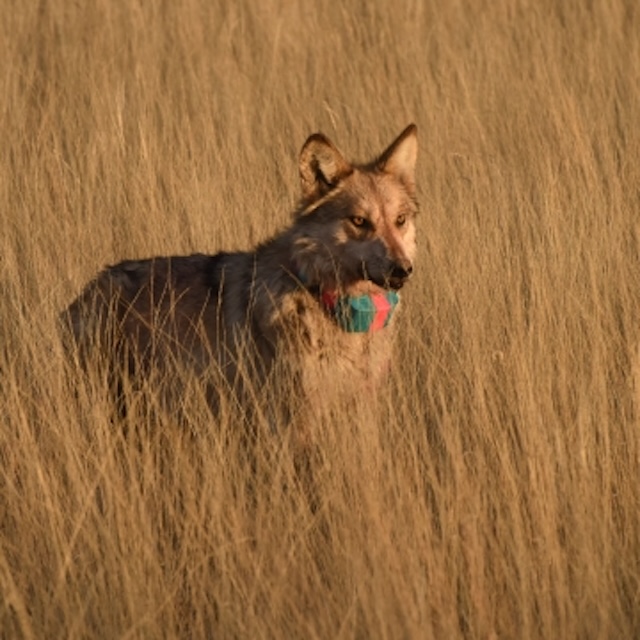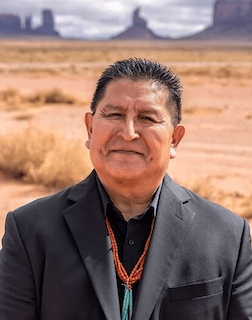
‘The same voice that would say that the only good Indian is a dead Indian is the one that says the only good wolf is a dead wolf.’ Shown here: a collared Mexican Wolf. Photo: John Bradley, USFWS
Anger over these wild creatures shows a lack of perspective
By Clark Tenakhongva
This story was originally published by High Country News
The hysteria around gray wolves across the United States, and Mexican wolves in particular, needs to be addressed urgently. First, the wolf named Ella was found murdered on ancestral Hopi lands, near Mount Taylor. A few weeks later, a collared wolf, Asiza, likely pregnant, was “mistakenly” murdered by Arizona Fish and Game in Greenlee County, also ancestral Hopi lands. It is my hope that by offering a perspective that predates the institutions “managing” these wild creatures, perhaps some rational thinking and conversation can occur.
I’ve been ranching in Arizona for over 65 years–since I was three years old. During my childhood, I helped the family with our sheep herd. Spanish colonizers introduced sheep and cattle to Hopi and other tribes. We traded goods with the Spanish to establish our own flocks; this is why wool began to appear in Hopi textiles in the 1500s, post-contact. Prior to this time, we mostly hunted bighorn sheep and mountain goats and did not rely on domesticated animals for slaughter and trade. We are an agricultural society, and big game has always been part of our belief system that Hopi, animals and the landscape are connected.

Clark Tenakhongva: ‘Hopi ranches don’t have fencelines, and we honor the migration of all wild animals.’ Courtesy image,
After my service in the U.S. military, I returned to Hopi and began cattle ranching. My wife’s family had been raising cattle for years, but I bought my first four head around 1980. I’ve been ranching ever since, and existing alongside wild animals as my ancestors have for many generations. Hopi are one of the most ancient civilizations in the United States, and we have always co-existed with wolves. Our ancestral lands extend all the way into the White Mountains of Arizona, around the headwaters of the Little Colorado, and far beyond, into Central America, all the way to the Pacific Ocean to the west, and, to the North, our people migrated as far as northern Colorado and Montana, as well as to the Rio Grande to the east. Hopi have our own word for wolves, Kwewu. Much like wolves, we have now been confined to a remnant of our original lands, fenced in with arbitrary lines that do not represent our deep history, knowledge and kinship to the land.
Hopi ranches don’t have fencelines, and we honor the migration of all wild animals. In our spiritual worldview, wolves and other wildlife are people that roam the land. We believe that the Creator told them that they are scavengers who should control the population, that this is their norm. They take out the old, the weak, the sick. Whose right is it to say that someone or a wild animal cannot be in a place it has existed since time immemorial? We understand that we are on borrowed land, and that the Creator told us to live in harmony with the land and to treat it with respect. Does it not also say in the Bible that the Creator looked out onto what He made and said it was good?
Whose right is it to say that someone or a wild animal cannot be in a place it has existed since time immemorial?
It seems as though the urge to kill wolves and run from them in fear is part of a deeper problem. The same voice that would say that the only good Indian is a dead Indian is the one that says the only good wolf is a dead wolf. Shooting animals for sport, without honoring their lives, feels greedy, and like we are desensitized to the teachings from all of our respective cultures that we should respect the land. We kill to mount a head on our walls in our offices, not to harvest for our bodies, or we just kill and leave them to die, for no reason at all. When I heard about the death of the wolves–Ella and Asiza–I thought again of the parallels between the way Indigenous people and wild wolves are treated through policy and society. It is also hard for me to understand how we justify using our tax dollars to kill wolves that are considered a “nuisance” to ranchers. To Hopi, corn is the most sacred of all plants, and when a fellow rancher’s cattle destroyed my corn, I was well within my rights on Hopi to shoot his cows for the damage they inflicted on my crop, but I did not. I practiced patience, understanding and attempted to work something out with this rancher.
…we know that no matter how many attempts are made to eradicate us, or the wolves, that our culture and our ways of knowing and being will exist. We and the wolves persist, despite the odds.
Talking about the wolves has compelled me to work on an art piece that signifies the importance of the wolf to Hopi. We respect the wolf’s cunning abilities and powerful hunting skills. We are not threatened by her, we see her as part of the whole, and we always have. It is strange that while I was in the process of creating this art, ranchers were “creating” with Donald Trump Jr. and other decision makers to bring harm to wolves across the United States. I worked diligently in a similar process to protect Bears Ears, Chaco Canyon, and Ancestral Footprints to preserve our kivas and the landscapes where wild animals roam, and here we are again, in a destructive part of the cycle under the second Trump administration.
Perhaps because modern ranchers have such limited experience in existing alongside wolves, there is an insecurity based in misunderstanding and fear of what is wild and cannot be contained or controlled. It does not make sense to kill one wolf for an alleged death of a calf–with this logic, then entire herds of cattle would be killed due to overgrazing. There are many places in the West where entire ecosystems have been destroyed or turned into sand dunes due to too many cows on the landscape. Even as a rancher, I can see that overgrazing is harming our ability to keep water on the landscape. We Hopi have survived for tens of thousands of years because we know that when we harm the land and the animals, we harm ourselves, that we are connected.
Hopi believes that we are all given the breath of life to live in good harmony with the land, animals and environment to the best benefit of both sides. And we know that no matter how many attempts are made to eradicate us, or the wolves, that our culture and our ways of knowing and being will exist. We and the wolves persist, despite the odds.

Clark Tenakhongva was born in Keams Canyon, Arizona, in 1957 and raised in the Third Mesa village of Hotevilla. His father is of the Corn and Water Clans. He is a U.S. Army veteran, the former vice chairman of the Hopi Nation, and former co-chairman of the Bears Ears Inter-Tribal Coalition.


